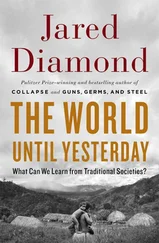Jared Diamond - Guns, Germs & Steel
Здесь есть возможность читать онлайн «Jared Diamond - Guns, Germs & Steel» весь текст электронной книги совершенно бесплатно (целиком полную версию без сокращений). В некоторых случаях можно слушать аудио, скачать через торрент в формате fb2 и присутствует краткое содержание. Жанр: 105. Описание произведения, (предисловие) а так же отзывы посетителей доступны на портале библиотеки ЛибКат.
- Название:Guns, Germs & Steel
- Автор:
- Жанр:
- Год:неизвестен
- ISBN:нет данных
- Рейтинг книги:5 / 5. Голосов: 1
-
Избранное:Добавить в избранное
- Отзывы:
-
Ваша оценка:
- 100
- 1
- 2
- 3
- 4
- 5
Guns, Germs & Steel: краткое содержание, описание и аннотация
Предлагаем к чтению аннотацию, описание, краткое содержание или предисловие (зависит от того, что написал сам автор книги «Guns, Germs & Steel»). Если вы не нашли необходимую информацию о книге — напишите в комментариях, мы постараемся отыскать её.
Guns, Germs & Steel — читать онлайн бесплатно полную книгу (весь текст) целиком
Ниже представлен текст книги, разбитый по страницам. Система сохранения места последней прочитанной страницы, позволяет с удобством читать онлайн бесплатно книгу «Guns, Germs & Steel», без необходимости каждый раз заново искать на чём Вы остановились. Поставьте закладку, и сможете в любой момент перейти на страницу, на которой закончили чтение.
Интервал:
Закладка:
FURTHER READINGS • 433
Haynes, Jr., an expert on the Clovis horizon and reported pre-Clovis sites, include "Contributions of radiocarbon dating to the geochronology of the peopling of the New World," pp. 354-74 in R. E. Taylor, A. Long, and r. S. Kra, eds., Radiocarbon after Four Decades (New York: Springer, 1992), and "Clovis-Folson geochronology and climate change," pp. 219-36 in Olga Soffer and N. D. Praslov, eds., From Kostenki to Clovis: Upper Paleolithic Paleo-Indian Adaptations (New York: Plenum, 1993). Pre-Clovis claims for the Pedra Furada site are argued by N. Guidon and G. Deli-brias, "Carbon-14 dates point to man in the Americas 32,000 years ago," Nature 321:769-71 (1986), and David Meltzer et al., "On a Pleistocene human occupation at Pedra Furada, Brazil," Antiquity 68:695-714 (1994). Other publications relevant to the pre-Clovis debate include T. D. Dillehay et al., "Earliest hunters and gatherers of South America," Journal of World Prehistory 6:145-204 (1992), T. D. Dillehay, Monte Verde: A Late Pleistocene Site in Chile (Washington, D.C.; Smithsonian Institution Press, 1989), T. D. Dillehay and D. J. Meltzer, eds., The First Americans: Search and Research (Boca Raton: CRC Press, 1991), Thomas Lynch "Glacial-age man in South America?—a critical review," American Antiq uity 55:12-36 (1990), John Hoffecker et al., "The colonization of Beringia and the peopling of the New World," Science 259:46-53 (1993), and A. C. Roosevelt et al., "Paleoindian cave dwellers in the Amazon: The peopling of the Americas," Science 272:373-84 (1996).
Chapter 2
Two outstanding books explicitly concerned with cultural differences among Polynesian islands are Patrick Kirch, The Evolution of the Polyne sian Chiefdoms (Cambridge: Cambridge University Press, 1984), and the same author's The Wet and the Dry (Chicago: University of Chicago Press, 1994). Much of Peter Bellwood's The Polynesians, rev. ed. (London: Thames and Hudson, 1987), also deals with this problem. Notable books dealing with specific Polynesian islands include Michael King, Moriori (Auckland: Penguin, 1989), on the Chatham Islands, Patrick Kirch, Feath ered Gods and Fishhooks (Honolulu: University of Hawaii Press, 1985), on Hawaii, Patrick Kirch and Marshall Sahlins, Anahulu (Chicago: University of Chicago Press, 1992), also on Hawaii, Jo Anne Van Tilburg, hland (Washington, D.C.: Smithsonian Institution Press, 1994),
434 * FURTHER READINGS
and Paul Bahn and John Flenley, Easter Island, Earth Island (London: Thames and Hudson, 1992).
Chapter 3
My account of Pizarro's capture of Atahuallpa combines the eyewitness accounts by Francisco Pizarro's brothers Hernando Pizarro and Pedro Pizarro and by Pizarro's companions Miguel de Estete, Cristobal de Mena, Ruiz de Arce, and Francisco de Xerez. The accounts by Hernando Pizarro, Miguel de Estete, and Francisco de Xerez have been translated by Clements Markham, Reports on the Discovery of Peru, Hakluyt Society, 1st ser., vol. 47 (New York, 1872); Pedro Pizarro's account, by Philip Means, Relation of the Discovery and Conquest of the Kingdoms of Peru (New York: Cortes Society, 1921); and Cristobal de Mena's account, by Joseph Sinclair, The Conquest of Peru, as Recorded by a Member of the Pizarro Expedition (New York, 1929). The account by Ruiz de Arce was reprinted in Boletin de la Real Academia de Historia (Madrid) 102:327-84 (1933). John Hemming's excellent The Conquest of the Incas (San Diego: Harcourt Brace Jovanovich, 1970) gives a full account of the capture and indeed of the whole conquest, with an extensive bibliography. A 19th-century account of the conquest, William H. Prescott's History of the Con quest of Peru (New York, 1847), is still highly readable and ranks among the classics of historical writing. Corresponding modern and classic 19th-century accounts of the Spanish conquest of the Aztecs are, respectively, Hugh Thomas, Conquest: Montezuma, Cortes, and the Fall of Old Mexico (New York: Simon and Schuster, 1993), and William Prescott, History of the Conquest of Mexico (New York, 1843). Contemporary eyewitness accounts of the conquest of the Aztecs were written by Cortes himself (reprinted as Hernando Cortes, Five Letters of Cortes to the Emperor note 14) and by many of Cortes's companions (reprinted in Patricia de Fuentes, ed., The Conquistadors note 15).
Chapters 4-10
References for these seven chapters on food production will be combined, since many of the references apply to more than one of them.
FURTHER READINGS • 435
Five important sources, all of them excellent and fact-filled, address the question how food production evolved from the hunter-gatherer lifestyle: Kent Flannery, "The origins of agriculture," Annual Reviews of Anthropology 2:271-310 (1973); Jack Harlan, Crops and Man, 2nd ed. (Madison Wis.: American Society of Agronomy, 1992); Richard MacNeish, The Origins of Agriculture and Settled Life (Norman: University of Oklahoma Press, 1992); David Rindos, The Origins of Agriculture: An Evolutionary Perspective (San Diego: Academic Press, 1984); and Bruce Smith, The Emergence of Agriculture (New York: Scientific American Library, 1995). Notable older references about food production in general include two multi-author volumes: Peter Ucko and G. W. Dimbleby, eds., The Domesti cation and Exploitation of Plants and Animals (Chicago: Aldine, 1969), and Charles Reed, ed., Origins of Agriculture (The Hague: Mouton, 1977). Carl Sauer, Agricultural Origins and Dispersals (New York: American Geographical Society, 1952), is a classic early comparison of Old World and New World food production, while Erich Isaac, Geography of Domestication (Englewood Cliffs, N. J.: Prentice-Hall, 1970), addresses the questions of where, when, and how regarding plant and animal domestication.
Among references specifically about plant domestication, Daniel Zohary and Maria Hopf, Domestication of Plants in the Old World, 2nd ed. (Oxford: Oxford University Press, 1993), stands out. It provides the most detailed account of plant domestication available for any part of the world. For each significant crop grown in western Eurasia, the book summarizes archaeological and genetic evidence about its domestication and subsequent spread.
Among important multi-author books on plant domestication are C. Wesley Cowan and Patty Jo Watson, eds., The Origins of Agriculture (Washington, D.C.: Smithsonian Institution Press, 1992), David Harris and Gordon Hillman, eds., Foraging and Farming: The Evolution of Plant Exploitation (London: Unwin Hyman, 1989), and C. Barigozzi, ed., The Origin and Domestication of Cultivated Plants (Amsterdam: Elsevier, 1986). Two engaging popular accounts of plant domestication by Charles Heiser, Jr., are Seed to Civilization: The Story of food, 3rd ed. (Cambridge: Harvard University Press, 1990), and Of Plants and People (Norman: University of Oklahoma Press, 1985). J. Smartt and N. W. Simmonds, ed., Evolution of Crop Plants, 2nd ed. (London: Longman, j) is the standard reference volume summarizing information about or the world's major crops and many minor ones. Three excellent
4 3 6 ' FURTHER READINGS
papers describe the changes that evolve automatically in wild plants under human cultivation: Mark Blunder and Roger Byrne, "The ecological genetics of domestication and the origins of agriculture," Current Anthropology 32:23-54 (1991); Charles Heiser, Jr., "Aspects of unconscious selection and the evolution of domesticated plants," Euphytica 37:77-81 (1988); and Daniel Zohary, "Modes of evolution in plants under domestication," in W. F. Grant, ed., Plant Biosystematics (Montreal: Academic Press, 1984). Mark Blumler, "Independent inventionism and recent genetic evidence on plant domestication," Economic Botany 46:98-111 (1992), evaluates the evidence for multiple domestications of the same wild plant species, as opposed to single origins followed by spread.
Among writings of general interest in connection with animal domestication, the standard encyclopedic reference work to the world's wild mammals is Ronald Nowak, ed., Walker's Mammals of the World, 5th ed. (Baltimore: Johns Hopkins University Press, 1991). Juliet Glutton-Brock, Domesticated Animals from Early Times (London: British Museum note 16, 1981), gives an excellent summary of all important domesticated mammals. I. L. Mason, ed., Evolution of Domesticated Animals (London: Longman, 1984), is a multi-author volume discussing each significant domesticated animal individually. Simon Davis, The Archaeology of Animals (New Haven: Yale University Press, 1987), provides an excellent account of what can be learned from mammal bones in archaeological sites. Juliet Glutton-Brock, ed., The Walking Larder (London: Unwin-Hyman, 1989), presents 31 papers about how humans have domesticated, herded, hunted, and been hunted by animals around the world. A comprehensive book in German about domesticated animals is Wolf Herre and Manfred Rohrs, Haustiere zoologisch gesehen (Stuttgart: Fischer, 1990). Stephen Budiansky, The Covenant of the Wild (New York: William Morrow, 1992), is a popular account of how animal domestication evolved automatically from relationships between humans and animals. An important paper on how domestic animals became used for plowing, transport, wool, and milk is Andrew Sheratt, "Plough and pastoralisnv. Aspects of the secondary products revolution," pp. 261-305 in lan Hod-der et al., eds., Pattern of the Past (Cambridge: Cambridge University Press, 1981).
Accounts of food production in particular areas of the world include a deliciously detailed mini-encyclopedia of Roman agricultural practices, Pliny, Natural History, vols. 17-19 (Latin text side-by-side with English;
Интервал:
Закладка:
Похожие книги на «Guns, Germs & Steel»
Представляем Вашему вниманию похожие книги на «Guns, Germs & Steel» списком для выбора. Мы отобрали схожую по названию и смыслу литературу в надежде предоставить читателям больше вариантов отыскать новые, интересные, ещё непрочитанные произведения.
Обсуждение, отзывы о книге «Guns, Germs & Steel» и просто собственные мнения читателей. Оставьте ваши комментарии, напишите, что Вы думаете о произведении, его смысле или главных героях. Укажите что конкретно понравилось, а что нет, и почему Вы так считаете.










